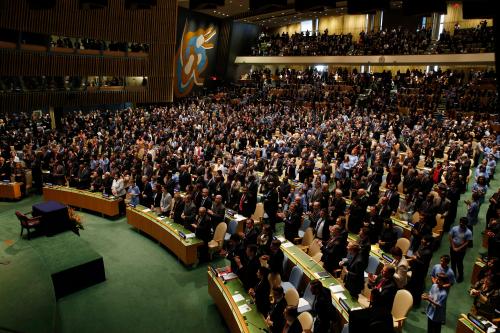Africa is characterized by an infrastructural deficit, a situation that remains critical. In fact, across the continent, 319 million people are living without access to improved reliable drinking water sources, 695 million people are living without basic sanitation access, only 34 percent have road access, and 620 million people don’t have access to electricity (sub-Saharan Africa). These insufficient infrastructure networks across the continent have limited cross-border flows of trade, capital, information, and people, drastically affecting Africa’s growth and broader development performance and regional integration. The Program for Infrastructure Development in Africa (PIDA), a continental initiative aimed at tackling the infrastructure deficits in Africa by 2040, should address these major gaps, but the effort is a long way from meeting its potential.
The reality gap: PIDA has made progress, but not fast enough to bridge the infrastructure gap by 2040
PIDA was created to address the failures of previous infrastructure initiatives. These breakdowns included incomplete information, inadequate causal analysis, lack of politically accepted and technically justified priorities, poor implementation, and lack of regulatory frameworks and incentives. In response, PIDA’s founders and leadership have developed a more comprehensive set of instruments: the Service Delivery Mechanism for technical assistance, the Continental Business Network for public-private partnerships, the Policy and Regulatory Framework for the continental harmonization of the legislation, the M&E and Information Management Framework to evaluate progress, and the Presidential Infrastructure Champion Initiative (PICI) to fast track project implementation by assigning project ownership to a government official or head of state.
Despite the development of these and other instruments intended to create a new dynamic for timely and effective infrastructure development in Africa, only four of the 51 major programs have reached advanced phases of implementation in 2015, according to the World Economic Forum. Most projects are only in the early needs assessment or funding proposal phase. Given that, prior to PIDA, the continent had only secured 5 percent of its infrastructure investment needs between 2004 and 2013, the slow progression toward bridging the infrastructure gap by 2040 is unsurprising.
PIDA should be a more vigorous catalyst for resource mobilization, especially from the private sector
PIDA has explored various sources of funding, but its ability to meet its financing goals remains uncertain. Supporting initiatives such as the Dakar Financing Summit, the Africa50 Investment Fund (an infrastructure investment platform), and the 5 Percent Agenda Initiative were launched to secure financing for Africa infrastructure, but the resources mobilized are thus far meager compared to the needs.
Numerous financing options are on the table for Africa. Despite external financing tripling over eight years (2004 to 2012), however, public sector investment remains dominant, private sector investment is lagging, and subnational infrastructure requires enhanced attention. Numerous studies have proposed various resource mobilization strategies, including pension funds, enhanced governance, and innovative strategies for oil exporters, among others. Credible options have been broadly studied, and it is time to accelerate their implementation. Importantly, though, corruption and lack of competency must not be tolerated.
Moving forward, PIDA should play a more efficient and strong coordinating role in resource mobilization at the continental level in a way that ensures compliance—one of the key arguments developed in my forthcoming book (African Development, African Transformation: How Institutions Shape Development Strategy? – Cambridge University Press). It should go beyond facilitation to create or stimulate the creation, with other partners, of appropriate infrastructure investment vehicles (listed infrastructure funds, private-equity type of investments, etc.). Credible options have been broadly studied, and it is time to accelerate their implementation.
PIDA should develop more effective implementation delivery units
To be successful, PIDA must address many of its implementation challenges. For example, the Presidential Infrastructure Champion Initiative (PICI) still has a long way to go. By designating heads of state or government as champions of specific projects, PICI gives them the responsibility to accelerate their successful completion as they must “bring visibility, unblock bottlenecks, co-ordinate resource mobilization and ensure project implementation.” The presidents of Algeria, Nigeria, Senegal, South Africa, Republic of the Congo, Rwanda, Egypt, and Kenya have pioneered the use of PICI for the implementation of regional projects.[1]
While a few countries, such as Algeria and Rwanda, have made substantial progress, others such as Nigeria, South Africa, and the Republic of the Congo have lagged. Various excuses have been made, such as political instability, but this brings us back to the importance of the notion of accountability and compliance, even at the presidential level.
Moving forward, policymakers should consider the implementation literature that explains the gap between policy formulation targets and implementation outcomes, as well as find inspiration in the key factors for successful policy delivery. They can create, for example, centralized and accountable policy implementation delivery units with transparent and regular monitoring, assessments, and correction of clearly identified deliverables. Where such institutions already exist, they should ensure strict compliance. Successful implementation of the already funded projects is also one of the best indicators of the seriousness of African political leaders seeking infrastructure financing.
They have no more excuses.
[1] The projects are: Missing Links on the Trans-Sahara Highway and Optic Fibre Link between Algeria and Nigeria via Niger by President Abdelaziz Bouteflika of Algeria; the Nigeria-Algeria Gas Pipeline Project (Trans-Sahara Gas Pipeline) by President Muhammadu Buhari of Nigeria; Dakar-Ndjamena-Djbouti Road/Rail Project by President Macky Sall; North-South Corridor Road/Rail Project by President Jacob Zuma of South Africa; Kinshasa-Brazzaville Bridge Road/Rail Project by President Denis Sassou Nguesso; Unblocking Political Bottlenecks for ICT Broadband and Optic Fibre Projects Linking Neighbouring States by President Paul Kagame of Rwanda; Construction of Navigational Line between Lake Victoria and the Mediterranean Sea by President Abdel Fattah el-Sisi of Egypt; and Lamu Port Southern Sudan-Ethiopia Transport Corridor Project by President Uhuru Kenyatta of Kenya.









Commentary
The road ahead for fixing Africa’s infrastructure deficit
November 16, 2017